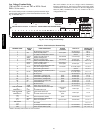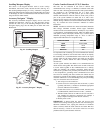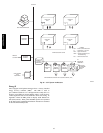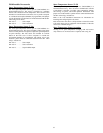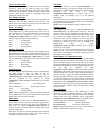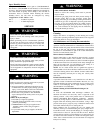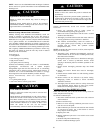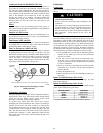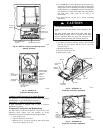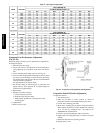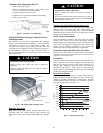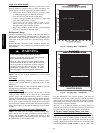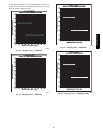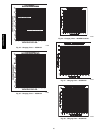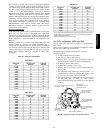
84
Condensate Drain Pan (48/50PM16−28 Units)
Check and clean each year at the start of the cooling season. An
access panel is located above the condensate connection to allow
easy clean out of the condensate pan. The first time the panel is
removed, the insulation behind the access panel will need to be cut
away. Carefully cut the insulation with a knife or blade on three
sides so the insulation can be folded out of the way during
cleaning. Be careful not to damage components behind the
insulation while cutting. Once cleaning is completed, fold the
insulation back into place and secure the access panel in the
original position.
Filters
Clean or replace at start of each heating and cooling season, or
more often if operating conditions require. Refer to unit Installation
Instructions for type and size.
Outdoor−Air Inlet Screens
Clean screens with steam or hot water and a mild detergent. Do
not use throwaway filters in place of screens. See unit installation
instructions for quantity and size.
Main Burner (48PG and PM)
At the beginning of each heating season, inspect for deterioration
or blockage due to corrosion or other causes. Observe the main
burner flames. Refer to Main Burners section.
Flue Gas Passageways (48PG and PM)
The flue collector box and heat exchanger cells may be inspected
by opening heat section access door (Fig. 5), flue box cover, and
main burner assembly. (See Fig. 50.) Refer to Main Burners section
for burner removal sequence. If cleaning is required, clean tubes
with a wire brush. Use Caution with ceramic heat exchanger
baffles. When installing retaining clip, be sure the center leg of the
clip extends inward toward baffle. (See Fig. 49.)
CERAMIC
BAFFLE
CLIP
NOTE: One baffle and clip will be in each upper tube of the heat exchanger.
C07260
Fig. 49 − Removing Heat Exchanger Ceramic
Baffles and Clips
Combustion−Air Blower
Clean periodically to assure proper airflow and heating efficiency.
Inspect blower wheel every fall and periodically during heating
season. For the first heating season, inspect blower wheel
bi-monthly to determine proper cleaning frequency.
To inspect blower wheel, open heat section door. Using a
flashlight, look into the flue exhaust duct to inspect. If cleaning is
required, remove motor and wheel assembly by removing the
screws holding the flue box cover to the flue box. (See Fig. 50 or
51.) Remove the screws holding the inducer housing to the inlet
plate. The wheel can then be removed from the motor shaft and
cleaned with a detergent or solvent. Replace the wheel onto the
motor shaft in the correct position and reassemble the flue cover
onto the flue box.
Lubrication
Compressors
Each compressor is charged with the correct amount of oil at the
factory.
UNIT DAMAGE HAZARD
Failure to follow this caution may result in damage to unit
components.
The compressor is in a Puron refrigerant system and uses a
polyolester (POE) oil. This oil is extremely hygroscopic,
meaning it absorbs water readily. POE oils can absorb 15
times as much water as other oils designed for HCFC and
CFC refrigerants. Avoid exposure of the oil to the
atmosphere.
CAUTION
!
Polyolester (POE) compressor lubricants are known to cause long
term damage to some synthetic roofing materials. Exposure, even if
immediately cleaned up, may cause roofing materials to become
brittle (leading to cracking) within a year. When performing any
service which may risk exposure of compressor oil to the roof, take
appropriate precautions to protect roofing. Procedures which risk
oil leakage include compressor replacement, repairing refrigerant
leaks, and replacing refrigerant components. To prepare rooftop:
1. Cover extended roof work area with an impermeable plastic
dropcloth or tarp. Make sure a 10 x 10 ft area around the
work area is covered.
2. Cover area in front of the unit service panel with a terry
cloth shop towel to absorb lubricant spills and prevent
run-offs. Towel will also protect dropcloth from tears caused
by tools or components.
3. Place terry cloth shop towel inside the unit directly under
components to be serviced to prevent spills through the
bottom of the unit.
4. Perform the required service.
5. Remove and dispose of any oil contaminated material per
local codes.
Indoor Fan Shaft Bearings (Sizes 03−14)
The indoor fan has permanently sealed bearings. No field
lubrication is necessary.
Indoor Fan Shaft Bearings (Sizes 16−28)
Lubricate bearings at least every 6 months with suitable bearing
grease. Typical lubricants are given below:
MANUFACTURER LUBRICANT
Texaco
Regal AFB‐2*
Mobil
Mobilplex EP No. 1
Sunoco
Prestige 42
Texaco
Multifak 2
* Preferred lubricant because it contains rust and oxidation inhibitors.
48/50PG and PM



